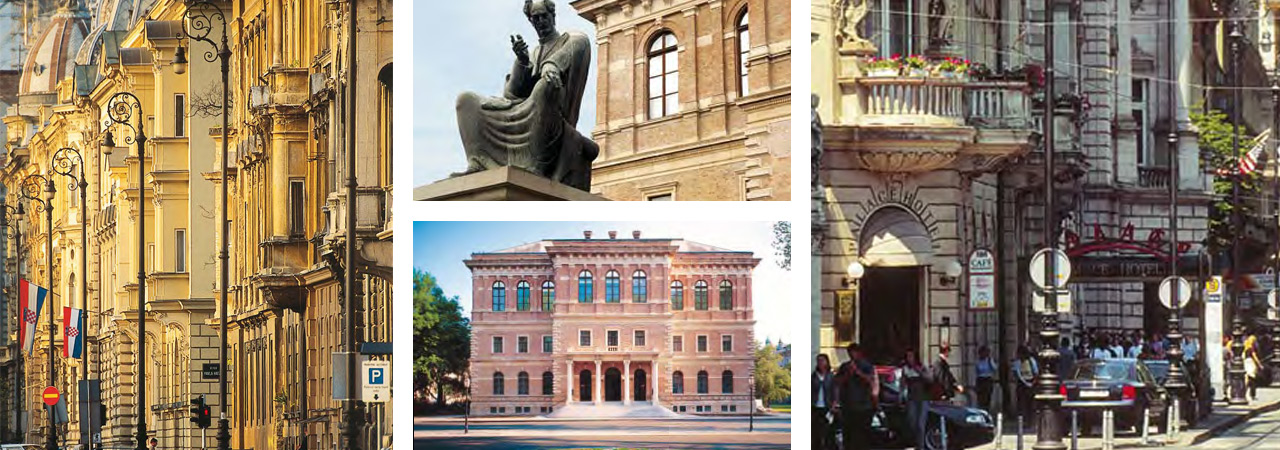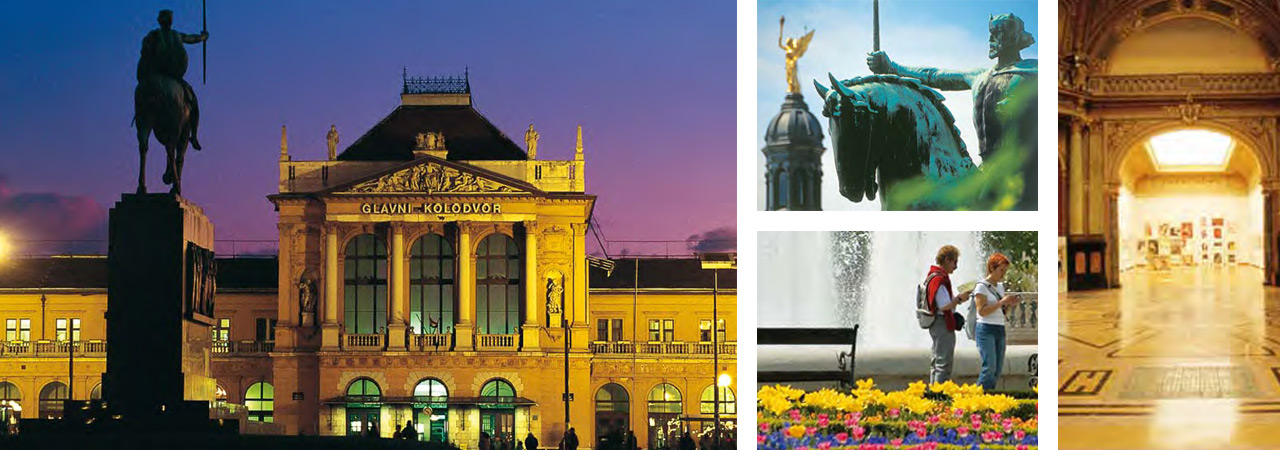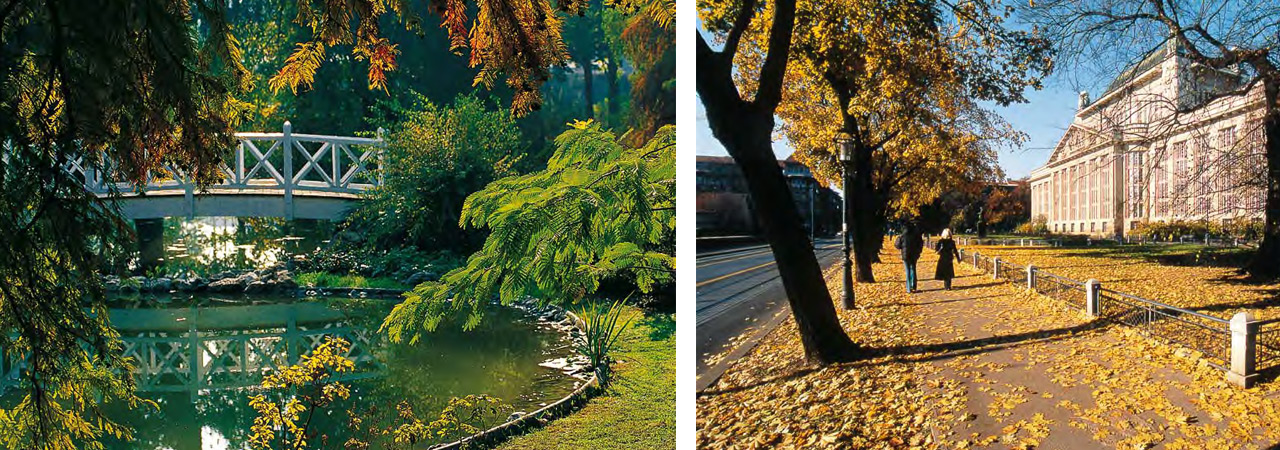The city of Zagreb, capital of Croatia, on the historic and political threshold between West and East, illustrates both the continental and Mediterranean spirit of the nation it spearheads. Zagreb is the cultural, scientific, economic, political and administrative centre of the Republic of Croatia, and is home to the Croatian Parliament, Government and President. Its favourable location between the Pannonian plain, the edge of the Alps and the Dinaric range has allowed it to become a crossing point for mass international communication. The city is protected from the cold northern winds by the mountain of Medvednica and opens up to the rest of the world thanks to a spacious plain and the Sava river. Over the centuries, the city was inhabited by people coming from all over Europe; and, in recent years, by people coming from different parts of Croatia, ensuring a rich cultural life. Zagreb is a safe city whose doors are always open; a city with a tumultuous history teeming with interesting personalities; a city that warmly invites all those who wish to get to know it. The façades of Zagreb’s buildings reflect the ebb and flow of history, while its streets and squares bear witness to the coming together of the many cultures that have shaped the identity of this laid-back capital. The streets and monuments of Zagreb proudly testify to its thousands of years of history.
ABOUT ZAGREB
Zagreb – a bridge between West and East

You can find spaces for recreation almost anywhere around Zagreb. Also, within easy reach we find Medvednica mountain, a popular destination for hiking, skiing, picknics. Right in the city centre, parks, streets and squares intersect with green spaces and gardens. Landscaped in the 19th century, Strossmayer Promenade in the Upper Town is where you can enjoy a romantic panorama of Zagreb in the company of the poet A.G. Matoš, a famous sculpture. Further evidence of 19th-century urban planning is visible in the so-called Green Horseshoe, combination of parks and squares in the city center.
The beating heart of Zagreb is Ban Josip Jelačić Square, Zagreb’s central square. All streets lead to this Square and the old clock has served as a beloved meeting point for generations of citizens, going on dates or just meeting friends after buying groceries at the main city market Dolac. A huge equestrian statue of Ban Josip Jelačić dominates the square. Both the Ban and his monument hold important places in the stormy history of Croatia. At Manduševac Fountain, a legend lives on – a coin thrown into this wishing well might change your life.

Just around the corner from the central square is one of the most romantic places in Zagreb, Zrinjevac Park. Your first impression will be of a green and floral promenade – this is where art lovers flock in droves. Your attention is soon drawn to the pretty flowerbeds and water fountains, and to the appearance of a meteorological station. There are few towns where streets and greenery live as closely intertwined as they do in Zagreb. In the heart of Zrinjevac there stands the Music Pavilion which has served as an open-air concert stage since the 19th century. Those arriving by train are first greeted by lovely views of King Tomislav square, named after the first Croatian king; the Art Pavilion and Zagreb Cathedral. The Art Pavilion, venue for special cultural events, was originally the Croatian Pavilion at the Millennium Exhibition in Budapest in 1896. Its innovative iron construction made it possible to transport it to its present location and for it to open to the Zagreb public two years later. Nearby nestles another green oasis, the Botanical Gardens, containing one of the most splendid plant collections in Europe, with some 10,000 varieties.
Atop the main square, sits the Cathedral, overlooking Ribnjak (‘Fishpond’), a beautiful park where clergymen used to catch fish for their Friday meal. In the eastern part of the city stretches spacious Maksimir, Zagreb’s biggest park was landscaped in the 19th century, in what was considered the English style. It later became home to many animals when a Zoo was opened here in the first half of the 20th century.
Outside the limits of the city centre, up on the hill, stands the main cemetery of Mirogoj. Its monumental arcades, pavilions and domes were designed in the late 19th century by prominent architect Hermann Bollé. One of the most beautiful cemeteries in Europe and the resting place for many public figures, Mirogoj is a lovely park in its own right, as well as an open-air art gallery.

History
Zagreb as we know it today, which is to say its historical centre, dates back to the Middle Ages, and the settlements on two hills: secular Gradec, today known as the Upper Town; and ecclesiastical Kaptol. The first written record of Zagreb dates back to 1094 when the Hungarian king Ladislav established the Kaptol diocese on his way to the Adriatic Sea. The Zagreb Cathedral still dominates the skyline with its neo-Gothic style, while the Renaissance walls surrounding it are rare preserved examples of their kind in this part of Europe. During the Mongol invasions of central Europe another historic event occurred here, and one that would greatly impact on Gradec, the other half of Zagreb’s core. In the mid-13th century the Tatars ravaged Hungary and their king Béla IV fled to Zagreb where its citizens provided him with a refuge. In gratitude, in 1242 Béla gave Gradec a charter proclaiming it a free royal city. His generosity is symbolically reenacted every day by the blasting of the cannon at noon from the Lotrščak tower overlooking central Zagreb.

In the Middle Ages bells were sounded to warn the citizens to return to the fort as the gates to the city were about to be closed and locked. The only gate preserved from the Middle Ages, Kamenita vrata, was burned down in the first half of the 18th century. Miraculously, the only thing saved in the fire was an icon of the Virgin Mary that still occupies its prime spot in the wall. The two hills, adversaries in the Middle Ages, were separated by the Medveščak creek and its mills. The creek valley sat along the presentday street of Tkalčićeva and it still runs underneath it, out towards the river Sava. In time the threats of attack subsided and the city started to spread out around the valley. he twin settlements on the hills prospered.
Baroque mansions and churches were built in the 17th and 18th centuries. The Jesuit order built St. Catherine’s Church, considered one of the best preserved examples of Baroque ecclesiastical splendour. In the second half of the 17th century, Zagreb became a university centre, one of the longest existing in Europe. In the meantime, Zagreb also became the seat of government. Differences between the ecclesiastical city and the free royal borough slowly disappeared and the two finally merged in 1850 to form the unified city of Zagreb, with a population of 15,000. The new city’s position enabled unhindered growth and Zagreb soon spread around the valley of the river Sava. The development of industrial production, commerce, transport and banking during the second half of the 19th century made their mark on the city’s appearance. In 1862 Zagreb expanded to the railway that has connected it with all other central European capitals to the present day. This is when the city started to develop along gridlines. The townplanning scheme strictly outlined that all streets must be straight and of the same width, and all buildings of the same type and height. Spacious squares and monuments in the neo-styles of the 19th century are seen among the many parks and green spaces that comprise the appearance of present-day Zagreb. Praška leads us away from the main square to the so-called Green Horseshoe. This series of open green spaces, not unlike the Ring in Vienna, is formed in the shape of the letter ‘u’ and contains important institutions of public culture. The ratio of greenery to the urban architecture, fountains and pavilions was carefully planned out. This is where the main railway station, Glavni kolodvor, is located, as well as the Academy of Sciences and Arts, the University Library, the National Theatre, noblemen’s palaces and numerous colleges. Yellow-tinted façades and lines of wild chestnut trees echo the era when Croatia was part of the Austro-Hungarian dual monarchy. The old Upper Town evolved into a systematically organised area with clearly defined sections of greenery and carefully located monuments. Building entrances around the Lower Town provide a link between public thoroughfares and the private sphere of residential courtyards. This atmospheric mix of small town and luxurious Central-European metropolis raised Zagreb to the level of contemporary cities to be reckoned with during the nineteenth century.

The historic events of the 20th century transformed the map of the world and left a mark on the lives of citizens of Zagreb. In 1918, after the World War I, Croatia severed all bonds with the Austro-Hungarian Monarchy and became a part of the Kingdom of Serbs, Croats and Slovenes, a new state formed by the south Slav peoples. The population of Zagreb increased and new districts emerged in the eastern and western parts of the city, while impressive residences were built in the foothills of Sljeme. In this early part of the 20th century, Zagreb developed close links with other European centres of art, culture and science. It was at this point that the first radio station in this part of Europe began to broadcast; the Zagreb Stock Exchange opened; the first automatic telephone exchange was built, as well as the city’s first skyscraper.
Modern times continued to change the everyday life of local citizens until the outbreak of World War II. After the war Croatia, with Zagreb as its capital, became one of the six republics of Yugoslavia. The post-war years lead to the further expansion of the city. It finally spread over the south bank of the river Sava with the construction of residential blocks. For centuries, the Sava had been flooding the valley while protecting citizens from medieval invasion and serving as a link to distant lands. From the mid-20th century it became the border between the old town of Zagreb and Novi Zagreb. Today there are twelve bridges connecting north and south, new and old. The Zagreb Fair, a venue for international business conventions, moved across to the south bank of the river. Pleso airport was built in the valley; around town, office blocks sprang up, along with a new National and University Library.
In 1991 the Croatian Parliament proclaimed the independence of Croatia as a sovereign state. Zagreb became the capital of a newly independent European nation, in a society of free and equal citizens. The Parliament of Croatia and the Government have their seat in the Upper Town, the oldest secular centre of the city, where historic decisions have been made for centuries. In the new millennium, the city of Zagreb is the business centre of the region, a place for multilingual business communication, political debate and cultural exchange. Business quarters just outside metropolitan Zagreb are a response to the demands of modern life. Zagreb continues to be as involved in events in Europe and the world, as it always has done. (www.infozagreb.hr)

